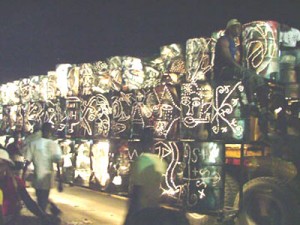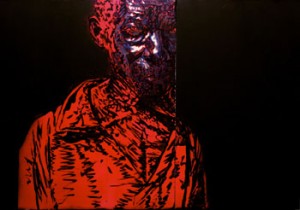« Features
Mario Benjamin: Reinventing the Past
By Ernesto Menéndez-Conde
For many artists of the so-called Third World, their cultural identity -if we can still use this term- is even in today’s global society, both a burden and an advantage. It is a burden because they are expected to create a body of work, which is somehow related to their cultural heritage. But it is also somewhat of an advantage, because the art market has room for these “authentic” revivals of otherness. To a certain extent, it seems difficult for these artists to go beyond stereotypes, and to offer views of their past or the traditions of their own countries under the light of our contemporary world. If we think of Haitian art, for instance, we might have in mind a colorful, naïve painting, or representations of voodoo divinities, and practices.
The Haitian artist, Mario Benjamin (represented by Etra Fine Art in Miami) looks to disengage himself from these labels, which are strongly rooted in the mainstream contemporary artistic scenario. Benjamin is neither a practitioner of Voodoo, nor a Catholic (rather his personal beliefs lie within the Buddhist philosophy). Even though he is a self-taught artist, who began his training in Haiti, he doesn’t consider himself -and he is not- a naïve painter, and he negates any folkloristic or labeled attitude. When asked about artists who have influenced his work, he mentions Francis Bacon, Christian Boltanski and the German Expressionists. He declares himself happy to be living in the 21st Century, in which information runs faster than ever, and geographical boundaries seem to be increasingly less relevant.
This sense of belonging to the present doesn’t equate to forgetting either his past, or his own personal experiences, which nurture his creations. In fact, one of his installations was devoted to the Haitian Revolution of the late 18th Century. He is also in dealing with his identity as a Black man, and even with a Caribbean identity. But he approaches these sujets, from the perspective of Contemporary Art: installations, videos, collages, and paintings, in which there is an assimilation of hyperrealism and expressionism. Besides working on canvases and traditional techniques of painting, Benjamin uses non-conventional materials such as talcum powder, artificial flowers, hair, old furniture, or black lights.
There are certain features that give a sense of unity -and a personal touch- to the diversity of his artistic creation. First of all there is an integration of the individual and the collective unconsciousness. Benjamin’s portraits depict faces of Black men, who seem to be emerging from the shadows. These images have an intense expressiveness, which could easily be associated with personal, existential anguish. Benjamin himself has said he is interested in the representation of suffering, and his portraits are strongly psychological. At the same time, however, they reveal a sort of wilderness, a powerful intuition; as if human beings were still linked to nature or to an irrational, rather magical system of thought. If we look at these paintings as a group, as placed by Benjamin -in his installation Holograms, at the Kunstnernes hus, Oslo, Norway (2003), and other solo shows- we can perceive faces immersed, perhaps possessed by forces of the subconscious, the sexual, and the terrible. These energies are so dominant, so powerful that the paintings turn into representations of ugliness in the sense that Theodor Adorno defined it: Archaic ugliness, the cannibalistically-threatening cult masks and grimaces, was the substantive imitation of fear, which it disseminated around itself in expiation. (1)

Mario Benjamin. Collaboration work with: Andre Eugene, Guyodo, Celeur Jean-Herard. Ministry’s of Culture float. Port-au-Prince Carnival, Haiti, 2006. 130 steel barrels, paint , artificial lights. Photo: John Jean-Pierre. Courtesy of the artist.
In Benjamin’s installations we could also have a sense of this juxtaposition of the individual and the collective unconsciousness. In these cases rhythms create a flux, which could be linked to an overwhelming sense of the natural, and the magical way of thinking I mentioned earlier. In his show Les fleurs canibales, presented at the Galerie Monnin, Petion-Ville, Haiti (2007), there were some sculptural images of human figures decorated with patterns, which resemble the ones he included in the paintings hung on the wall. Through these affinities, Benjamin proposes a dialogue between the human body and nature. Men are represented in a hieratic way, with reminiscences of the archaic, as if they were priests in an unknown, perhaps secret, ritual.
Another relevant feature in Benjamin’s art pieces is the use of light. His portraits and installations, in which there are fluid representations of natural elements, present sharp contrasts between brightness and darkness. It could be said that light set against dark, black surfaces, has a phosphorescent quality. In every case light is very expressive. It adds an accent to an enigmatic and euphoric view of the world.
Finally, I would like to mention the importance of graphic elements. Benjamin’s images are jungles of lines, curves, and movements -sometimes chaotic and spontaneous, as in his series of portraits; sometimes following symmetrical structures, in which the same motif is repeated. But in every case colors are reduced to a narrow palette. Lines and rhythms play a main role in his work.
From his earliest combined painting surfaces, and collages- Benjamin’s works seem to have moved from representations of human faces to biomorphic elements. From rather dark images to brighter compositions and lighter environments; from chaotic gestures or accumulations -as in Maison, his installation shown at the Musée d’art haïtien, Port-au-Prince, Haïti, in 1997- to rhythms, which sometimes have an ornamental sense. There is also a movement towards formalistic features and patterns. His recent work has to do with environments, spaces, and the experience of walking through an art piece. However, Benjamin keeps transmitting a sense of intense expressiveness and enigma, which somehow seems to be intrinsic to both his personality and his cultural heritage.
Benjamin is creating a personal and expressionist view of Afro-Caribbean traditions through the language of postmodern art. He shows an Afro-Caribbean identity reluctant to be defined, ambivalent, which cannot be reduced to any particular belief, and which is still immersed in a strong, magical way of representation. It is an identity that dwells both in the realm of the psychological and the ancestral. It is a past under the light of Contemporary art.
Notes
1- Adorno, Theodor W. The Aesthetic Theory. University of Minnesota (1997), p 47.
Ernesto Menéndez-Conde is finishing a PHD in Romance Languages at Duke University. He has published in magazines in Havana, Spain, and New York. He has also collaborated with Marlborough Gallery and Sotheby’s in New York.



































